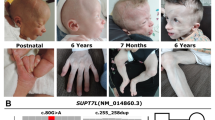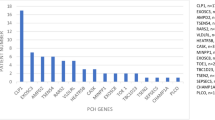Abstract
Autism spectrum disorder, severe behaviour problems and duplication of the Xq12 to Xq13 region have recently been described in three male relatives. To describe the psychiatric comorbidity and dysmorphic features, including craniosynostosis, of two male siblings with autism and duplication of the Xq13 to Xq21 region, and attempt to narrow down the number of duplicated genes proposed to be leading to global developmental delay and autism. We performed DNA sequencing of certain exons of the TWIST1 gene, the FGFR2 gene and the FGFR3 gene. We also performed microarray analysis of the DNA. In addition to autism, the two male siblings exhibited severe learning disability, self-injurious behaviour, temper tantrums and hyperactivity, and had no communicative language. Chromosomal analyses were normal. Neither of the two siblings showed mutations of the sequenced exons known to produce craniosynostosis. The microarray analysis detected an extra copy of a region on the long arm of chromosome X, chromosome band Xq13.1–q21.1. Comparison of our two cases with previously described patients allowed us to identify three genes predisposing for autism in the duplicated chromosomal region. Sagittal craniosynostosis is also a new finding linked to the duplication.





Similar content being viewed by others
References
Steinbach P, Horstmann W, Scholz W (1980) Tandem duplication dup(X)(q13q22) in a male proband inherited from the mother showing mosaicism of X-inactivation. Hum Genet 54:309–313
Vejerslev LO, Rix M, Jespersen B (1985) Inherited tandem duplication dup(X) (q131–q212) in a male proband. Clin Genet 27:276–281
Thode A, Partington MW, Yip MY, Chapman C, Richardson VF et al (1988) A new syndrome with mental retardation, short stature and an Xq duplication. Am J Med Genet 30:239–250
Yokoyama Y, Narahara K, Tsuji K, Moriwake T, Kanzaki S et al (1992) Growth hormone deficiency and empty sella syndrome in a boy with dup(X) (q13.3–q21.2). Am J Med Genet 42:660–664
Apacik C, Cohen M, Jakobeit M, Schmucker B, Schuffenhauer S et al (1996) Two brothers with multiple congenital anomalies and mental retardation due to disomy (X)(q12–>q13.3) inherited from the mother. Clin Genet 50:63–73
Shapira M, Dar H, Bar-El H, Bar-Nitzan N, Even L et al (1997) Inherited inverted duplication of X chromosome in a male: report of a patient and review of the literature. Am J Med Genet 72:409–414
Hou JW (2004) Inherited tandem duplication of the X chromosome: dup(X)(q13.2–q21.2) in a family. Chang Gung Med J 27:685–690
Kaya N, Colak D, Albakheet A, Al-Owain M, Abu-Dheim N et al (2012) A novel X-linked disorder with developmental delay and autistic features. Ann Neurol 71:498–508
Cremers FP, Pfeiffer RA, van de Pol TJ, Hofker MH, Kruse TA et al (1987) An interstitial duplication of the X chromosome in a male allows physical fine mapping of probes from the Xq13–q22 region. Hum Genet 77:23–27
Muscatelli F, Verna JM, Philip N, Moncla A, Mattei MG et al (1992) Physical mapping of an Xq-proximal interstitial duplication in a male. Hum Genet 88:691–694
Cheng SF, Rauen KA, Pinkel D, Albertson DG, Cotter PD (2005) Xq chromosome duplication in males: clinical, cytogenetic and array CGH characterization of a new case and review. Am J Med Genet A 135:308–313
Lugtenberg D, de Brouwer AP, Oudakker AR, Pfundt R, Hamel BC et al (2009) Xq13.2q21.1 duplication encompassing the ATRX gene in a man with mental retardation, minor facial and genital anomalies, short stature and broad thorax. Am J Med Genet A 149A:760–766
APA (1994) Diagnostic and statistical manual of mental disorders, 4th edition (DSM-IV). American Psychiatric Press, Washington
APA (1987) Diagnostic and statistical manual of mental disorders, 3rd edition revised (DSM-III-R). American Psychiatric Press, Washington
Krug DA, Aric J, Almond P (1980) Behavior checklist for identifying severly handicapped individuals with high levels of autistic behavior. J Child Psychol Psychiatry 21:221–229
Nordin V, Gillberg C (1996) Autism spectrum disorders in children with physical and mental disability or both. I. Clinical and epidemiological aspects. Dev Med Child Neurol 38:297–313
Saemundsen E, Juliusson H, Hjaltested S, Gunnarsdottir T, Haldisdottir T, Hreidarsson S et al (2010) Prevalence of autism in an urban population of adults with severe intellectual disabilities—a preliminary study. J Intellect Disabil Res 54:727–735
Jamain S, Quach H, Betancur C, Rastam M, Colineaux C et al (2003) Mutations of the X-linked genes encoding neuroligins NLGN3 and NLGN4 are associated with autism. Nat Genet 34:27–29
Raymond FL (2006) X linked mental retardation: a clinical guide. J Med Genet 43:193–200
Bourgeron T (2009) A synaptic trek to autism. Curr Opin Neurobiol 19:231–234
Michaelis RC, Copeland-Yates SA, Sossey-Alaoui K, Skinner C, Friez MJ et al (2000) The HOPA gene dodecamer duplication is not a significant etiological factor in autism. J Autism Dev Disord 30:355–358
Beyer KS, Klauck SM, Benner A, Poustka F, Poustka A (2002) Association studies of the HOPA dodecamer duplication variant in different subtypes of autism. Am J Med Genet 114:110–115
Visser WE, Swagemakers SM, Ozgur Z, Schot R, Verheijen FW et al (2010) Transcriptional profiling of fibroblasts from patients with mutations in MCT8 and comparative analysis with the human brain transcriptome. Hum Mol Genet 19:4189–4200
Megarbane A, Hersh JH, Chouery E, Fabre M (2002) Craniosynostosis, telecanthus, scalp hair abnormalities, and sensorineural deafness in two sibs. Am J Med Genet 109:323–327
Morey-Canellas J, Sivagamasundari U, Barton H (2003) A case of autism in a child with Apert’s syndrome. Eur Child Adolesc Psychiatry 12:100–102
Acknowledgments
The authors would like to thank the two boys, patient 1 and patient 2, and their family for their very helpful cooperation, without which this study would not have been possible.
Conflict of interest
The authors declare that they have no conflict of interest.
Author information
Authors and Affiliations
Corresponding author
Rights and permissions
About this article
Cite this article
Wentz, E., Vujic, M., Kärrstedt, EL. et al. A case report of two male siblings with autism and duplication of Xq13–q21, a region including three genes predisposing for autism. Eur Child Adolesc Psychiatry 23, 329–336 (2014). https://doi.org/10.1007/s00787-013-0455-1
Received:
Accepted:
Published:
Issue Date:
DOI: https://doi.org/10.1007/s00787-013-0455-1




